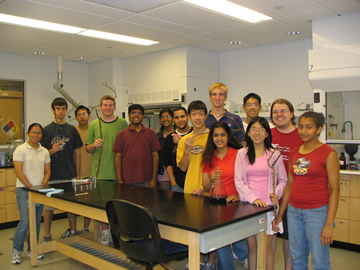|
|
2005 Team 2
|
CHEMICAL ANALYSIS OF TREES INFESTED BY THE ASIAN LONGHORNED BEETLE
Robert Bruce, Jr., Deepa Cherla, Pedro Duran, Josephine Li, Tanvi Rastogi, Aaron Sin, Gregory Springsted, Alex Yang, Divya Yerramilli, Rae Yoon Eric Yoo, Alex Zozula
Advisor: Jeremy Stanton
Assistant: Bhavik Shah
|
ABSTRACT
In the past few years, the Asian Longhorned Beetle ( Anoplophora glabripennis ) has infested various species of trees throughout the United States , and it threatens to do billions of dollars worth of damage. This study sought to identify various factors that may affect the selectivity of the Asian Longhorned Beetle (ALB) for specific host tree species. Trees studied included the Sugar Maple ( Acer sacrum ), White Willow ( Salix alba ), and Hackberry ( Celtis spp. ), all of which are known hosts of the ALB. The Eastern White Pine ( Pinus strobus ) functioned as a softwood control, and the Northern Red Oak ( Quercus rubra ) functioned as a hardwood control. The study focused on reducing sugar, protein, lignin, and extractive levels as well as the ratio of vascular vessel space to wood material. The team hypothesized that high sugar and protein content, low lignin content, and relatively little vessel space would lead to high levels of ALB infestation. Although experimental results for sugar and protein content were inconclusive, it appeared that the ALB marginally prefers trees with more lignin and less vessel spaces. For the extractives evaluation, the team investigated possible correlations between ALB infestation rates and the presence of certain compounds; dibutyl phthalate and benzenemethanol were identified as possible repellants of the ALB, but more studies are needed to determine the validity of these preliminary results. Possible sources of error include, but are not limited to the interdependency of variables, the use of different tree parts, and procedural and experimental inaccuracies. |
| |
|

Team 2 |
| |
| |
|
|


